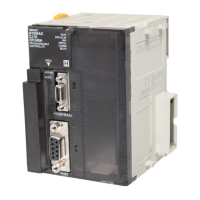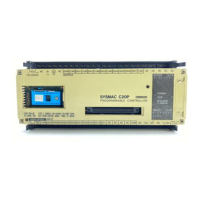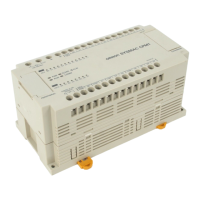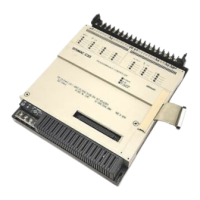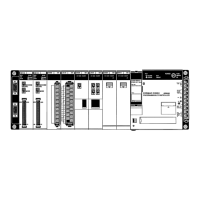12 13
NT Links (1:N Mode)
Programmable
Terminal
Programmable
Terminal
PLC-to-PT connection in NT Link (1:N mode) communi-
cations can be either one-to-one or one-to-many.
Construction of systems in multivendor env ironments simplified
with protocol macros.
The evolution of
the SYSMAC CS1 is
accelerating advances in
the production site.
More Ports for Even More
Serial Device Connections
Protocol macros make it easy to create
serial communications protocols
(communications frames, error checks,
retries, error processing, etc.) to match
those of remote communications
devices. Multiple ports are provided for
this function. Each PLC supports up to
16 Serial Communications Units (32
ports total) and one Serial
Communications Board (with 2 ports).
This makes it possible to connect up to
34 devices with serial communications
at a speed of 38.4 Kbps. Message
length has been increased from 256 to
1,000 bytes to give communications
more power than ever before.
When the CPU Unit (Ver. 3.0 or later) or
Serial Communications Board or Serial
Communications Unit (Ver. 1.2 or later)
receive a FINS command containing a
CompoWay/F command (see note 1) via
network or serial communications, the
command is automatically converted to
a protocol suitable for the message and
forwarded using serial communications.
Baud rate increased from 38,400 bps
to 57,600 bps for faster
communications.
Standard system protocol added for
greater connectability with
components and PLCs.
•CompoWay/F Master
•Host Link Master functions
•Mitsubishi Computer Link Master
CompoWay/F (See note 2.)
Host Link FINS
(Possible only with Serial Communications Boards or
Serial Communications Units Ver. 1.2 or later)
Windows-based Software
Simplifies Serial Device
Connections
Protocol macros for Serial
Communications Units and Boards can
be created using the CX-Protocol, thus
enabling message tracing and greatly
reducing the time involved in
connecting various serial devices.
Wide Range of Applicable
Protocols Allows for High
Value-added Programs
The CS1 Series supports a wide range
of serial communications protocols,
such as Host Link, no-protocol, NT Link,
peripheral bus, and more. These allow
for high value-added programs such as
MMI, communications, and data
processing.
The Fastest Communications
in the Industry with
High-speed NT Links
Combine with one of the NS Series
Programmable Terminals (NS8, NS10,
or NS12) to enable connecting High-
speed NT Links. Using NT Link
terminology together with a
communications speed of 115 Kbps
provides high-speed response.
Enhanced Protocol Macro
Functionality
Supports No-protocol Communications
(Serial Communications Units/Boards with Ver. 1.2 or later)
(CPU Unit Ver. 3.0 or later)
(Serial Communications Units/Boards with Ver. 1.2 or later)
(Serial Communications Units/Boards with Ver. 1.2 or later)
Serial Gateway
Note 1: FINS
Abbreviation for Factory Interface Network Service. A
command system for message services common to
OMRON networks. FINS commands can be sent across
up to 8 network levels, including serial
communications paths using a serial gateway.
(Possible only with CS/CJ-series CPU Unit Ver. 2.0 or
later.)
Note 2: CompoWay/F
CompoWay/F is an integrated communications
protocol used for OMRON general-purpose serial
communications. It is used by Temperature Controllers,
Digital Panel Meters, Timer/Counters, Smart Sensors,
Cam Positioners, Safety Controllers, etc. (as of July
2004).
Gateway
FINS network
Serial
communications
Component/PLC
Truly Seamless Incorporation of OMRON Components
and Other Devices into Networks
When CompoWay/F commands are
enclosed in FINS commands and sent
to Serial Communications Boards or
Serial Communications Units (Ver.
1.2) or serial ports on CPU Unit Ver.
3.0, the enclosed CompoWay/F
command is retrieved using a Serial
Gateway Function and sent as a
CompoWay/F command.
Serial Gateway System (Reference)
Serial
Communications
Board
Serial
Communications
Unit
FINS command received
Serial Gateway: FINS
command "capsule"
opened and contents
retrieved.
Sent as a CompoWay/F
command
Temperature
Controller
Smart Sensor
OMRON Components
No-protocol communications supported for Serial
Communications Units and Serial Communications
Boards
This mode enables components to be connected to
multiple communications ports using no-protocol
communications.
Serial port I/O instructions executable using no-
protocol communications from Serial
Communications Units and Serial Communications
Boards (TXDU, RXDU, TXD, and RXD) are
supported for CPU Units with Ver. 3.0 or later.
Serial Communications
Configuration Example
Host Links No-protocol
Sending Host Link and
FINS commands
Device
Response
TXD instruction
or
RXD instruction
using CPU Unit's
RS-232 port or Serial
Communications Board
TXD instruction
or
RXD instruction
using Serial
Communications
Unit
CPU Unit
RS-232C Port
Data input from
a bar code reader
Data output to printer
Reading and writing
of I/O memory and
operating modes
(Programming
Console bus)
CX-Programmer
CX-Protocol
CX-Motion
ASCII Unit Serial Communications Unit
Serial
Communications Board
CPU Unit
Host computer, etc.
Host Link
Programming Devices
Programming
Console
Peripheral bus
NT Link
Protocol macros
Protocol macros
Protocol macros
Programmable
Terminal
Non-OMRON
PLCs, etc.
Microcomputer,
etc.
Commercially-available
external device
Temperature controller,
bar code reader, etc.
General-purpose protocol
using BASIC in ASCII Unit
Commercially-available
external device

